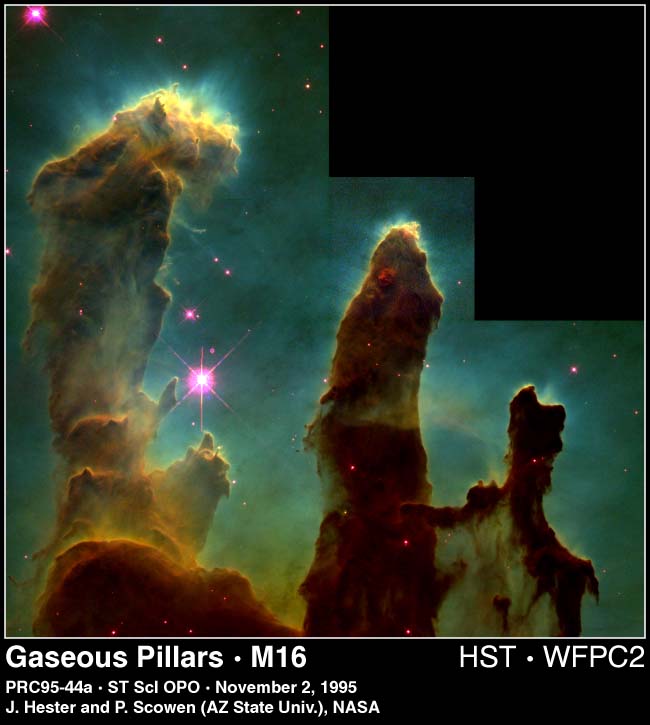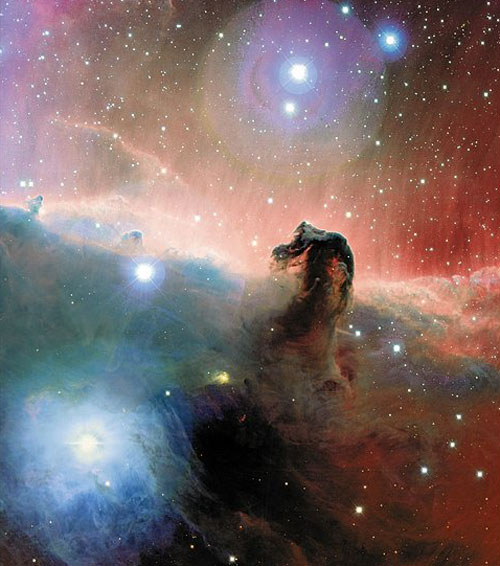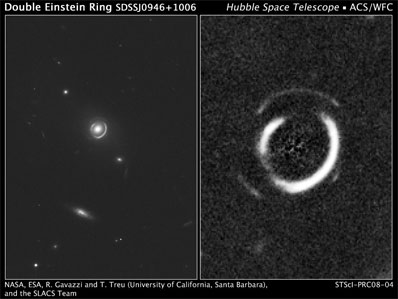Skip to comments.
NASA's Spitzer telescope captures image of young stars
ap on Bakersfield Californian ^
| 11/09/05
| AP
Posted on 11/09/2005 3:49:16 PM PST by NormsRevenge
PASADENA, Calif. (AP) - A dazzling photo taken by NASA's Spitzer Space Telescope shows colossal pillars of cool gas and dust, giving scientists an intimate look at the star-forming process.
The image released Wednesday shows the columns stretching out like fingers similar to an iconic photo taken of the Eagle Nebula by the Hubble Space Telescope in 1995. While the Hubble visible-light image was dubbed "Pillars of Creation," NASA describes the Spitzer infrared image as "cosmic mountains of creation."
The image reflects a region in space known as W5, in the constellation Cassiopeia 7,000 light years away, which is dominated by a single massive star.
The largest pillars - formed by radiation and winds from hot, massive stars - contains hundreds of newborn stars.
"We believe that the star clusters lighting up the tips of the pillars are essentially the offspring of the region's single, massive star," Lori Allen of the Harvard-Smithsonian Center for Astrophysics said in a statement.
Spitzer was able to spy the stars being born inside the pillars because of its infrared capability. A visible light telescope would see the same region as dark columns outlined by specks of light.
Scientists believe the pillars eventually become dense enough to give rise to a second generation of stars, which may in turn, trigger successive generations.
TOPICS: Culture/Society; Government; US: California
KEYWORDS: astronomy; captures; image; infraredobservatory; nasa; science; spitzer; spitzertelescope; telescope; youngstars

This undated infrared image captured by NASA's Spitzer Space Telescope, released by NASA on Wednesday, Nov. 9, 2005, shows colossal pillars of cool gas and dust that provide scientists with an intimate look at the star-forming process. The image reflects a region in space known as W5, in the constellation Cassiopeia 7,000 light years away, which is dominated by a single massive star. (AP Photo/NASA, JPL, CalTech)
To: NormsRevenge

This false-color image from NASA's Spitzer Space Telescope shows the 'mountains' where stars are born. Dubbed 'Mountains of Creation' by Spitzer scientists, these towering pillars of cool gas and dust are illuminated at their tips with light from warm, embryonic stars. The new infrared picture is reminiscent of Hubble's iconic visible-light image of the Eagle Nebula (inset), which also features a star-forming region, or nebula, that is being sculpted into pillars by radiation and winds from hot, massive stars. The pillars in the Spitzer image are part of a region called W5, in the Cassiopeia constellation 7,000 light-years away and 50 light-years across. They are more than 10 times in the size of those in the Eagle Nebula (shown to scale here). EDITORIAL USE ONLY REUTERS/NASA/JPL-Caltech/L. Allen/Handout
2
posted on
11/09/2005 3:50:18 PM PST
by
NormsRevenge
(Semper Fi ... Monthly Donor spoken Here. Go to ... https://secure.freerepublic.com/donate/)
To: KevinDavis
3
posted on
11/09/2005 3:51:24 PM PST
by
Las Vegas Dave
("Liberals out of power are comical-Liberals in power are dangerous!"-ElRushbo quote.)
To: Las Vegas Dave
4
posted on
11/09/2005 3:52:24 PM PST
by
NormsRevenge
(Semper Fi ... Monthly Donor spoken Here. Go to ... https://secure.freerepublic.com/donate/)
To: NormsRevenge
I thought focusing on "young stars" was the job of the National Enquirer...
.jpg)
5
posted on
11/09/2005 3:52:27 PM PST
by
ErnBatavia
(Frist would be a great Majority Leader if he had 65 seats..make that 75)
To: NormsRevenge
Visible light image of above images

6
posted on
11/09/2005 3:53:13 PM PST
by
NormsRevenge
(Semper Fi ... Monthly Donor spoken Here. Go to ... https://secure.freerepublic.com/donate/)
To: NormsRevenge
Remember Carl Sagan’s “mind ship” (or something like that). I surely wish I had one.
7
posted on
11/09/2005 3:56:24 PM PST
by
R. Scott
(Humanity i love you because when you're hard up you pawn your Intelligence to buy a drink.)
To: NormsRevenge
That danged Elliot Spitzer has gone to extremes now, with a telescope!!!
Don't these Dem prosecuters cum persecutors know when to back off???
8
posted on
11/09/2005 4:00:29 PM PST
by
SierraWasp
(The only thing that can save CA is making eastern CA the 51st state called Sierra Republic!!!)
To: ErnBatavia
"Spitzer was able to spy the stars being born inside the pillars"Is this the part that inspired you???
9
posted on
11/09/2005 4:02:26 PM PST
by
SierraWasp
(The only thing that can save CA is making eastern CA the 51st state called Sierra Republic!!!)
To: RightWhale; Brett66; xrp; gdc314; sionnsar; anymouse; RadioAstronomer; NonZeroSum; jimkress; ...
It seems that the Spitzer is doing a lot more than the Hubble..

10
posted on
11/09/2005 7:50:05 PM PST
by
KevinDavis
(http://www.cafepress.com/spacefuture)
To: NormsRevenge
I've seen many images similar to the star forming region you posted. I have a question for the audience here at FR, as I know there are some experts on-hand. The gas appears almost to be streaming away from a specific region of space.
Here is another:

It almost looks like columns of gas, or like there is some kind of pressure from the direction of where the top of the image is towards the bottom.
Is this an artifact of just the portion of the image selected making it appear this way? Perhaps if more of the picture were more visible it would be easier to tell if the cropped portion were truely a reflection of the structure or a just a feature of one small portion of the structure.
Just something I've wondered about occasionally. ;-)
11
posted on
11/09/2005 9:44:55 PM PST
by
zeugma
(Warning: Self-referential object does not reference itself.)
To: zeugma
I am not an expert by any means (the Holiday Inn stay notwithstanding) .. this is a small snapshot of a much large confluence of activity in the area.
I suspect what we are seeing here is a combination of hydrogen gas and other matter ie dust dispersing that gives it the flowing effect. This is another shot of the Eagle Nebula.

http://www.cosmiclight.com/imagegalleries/ourgalaxy.htm
About half way down this page is more info about this particular shot.
I think the Horsehead Nebula is another example of some weird flow.

http://antwrp.gsfc.nasa.gov/apod/ap031007.html
12
posted on
11/09/2005 9:59:16 PM PST
by
NormsRevenge
(Semper Fi ... Monthly Donor spoken Here. Go to ... https://secure.freerepublic.com/donate/)
To: NormsRevenge
The formation has been dubbed “The Eliot Nebula.” The image released were previously unseen by the Hummble Telescope.
13
posted on
01/10/2008 4:38:35 PM PST
by
Fitzy_888
("ownership society")
To: KevinDavis
This is about when Hubble essentially went offline. It’s been a couple years since fresh Hubble images, but they keep republishing the old ones.
14
posted on
01/10/2008 4:41:23 PM PST
by
RightWhale
(Dean Koonz is good, but my favorite authors are Dun and Bradstreet)
To: NormsRevenge
spaceflightnow.com
Hubble telescope discovers a double ‘Einstein ring’
SPACE TELESCOPE SCIENCE INSTITUTE NEWS RELEASE
Posted: January 10, 2008
The discovery is part of the ongoing Sloan Lens Advanced Camera for Surveys (SLACS) program.
Not all so slack after all
15
posted on
01/11/2008 11:30:17 AM PST
by
RightWhale
(Dean Koonz is good, but my favorite authors are Dun and Bradstreet)
To: RightWhale
Very cool stuff! Thanks

Telescope has revealed a never-before-seen optical alignment in space: a pair of glowing rings, one nestled inside the other like a bull's-eye pattern. The double-ring pattern is caused by the complex bending of light from two distant galaxies strung directly behind a foreground massive galaxy, like three beads on a string.
More than just a novelty, this very rare phenomenon can offer insight into dark matter, dark energy, the nature of distant galaxies, and even the curvature of the universe.
The ring was found by an international team of astronomers led by Raphael Gavazzi and Tommaso Treu of the University of California, Santa Barbara. The discovery is part of the ongoing Sloan Lens Advanced Camera for Surveys (SLACS) program. The team is reporting its results at the 211th meeting of the American Astronomical Society in Austin, Texas. A paper has been submitted to The Astrophysical Journal.
The phenomenon, called gravitational lensing, occurs when a massive galaxy in the foreground bends the light rays from a distant galaxy behind it, in much the same way as a magnifying glass would. When both galaxies are exactly lined up, the light forms a circle, called an "Einstein ring," around the foreground galaxy. If another background galaxy lies precisely on the same sightline, a second, larger ring will appear.
Because the odds of seeing such a special alignment are estimated to be 1 in 10,000, Tommaso says that they "hit the jackpot." The odds of seeing this phenomenon are less than winning two consecutive bets on a single number at Roulette.
"Such stunning cosmic coincidences reveal so much about nature. Dark matter is not hidden to lensing," added Leonidas Moustakas of the Jet Propulsion Laboratory in Pasadena, Calif. "The elegance of this lens is trumped only by the secrets of nature that it reveals."
The massive foreground galaxy is almost perfectly aligned in the sky with two background galaxies at different distances. The foreground galaxy is 3 billion light-years away. The inner ring and outer ring are comprised of multiple images of two galaxies at a distance of 6 billion and approximately 11 billion light-years.
SLACS team member Adam Bolton of the University of Hawaii's Institute for Astronomy in Honolulu first identified the lens in the Sloan Digital Sky Survey (SDSS). "The original signature that led us to this discovery was a mere 500 photons (particles of light) hidden among 500,000 other photons in the SDSS spectrum of the foreground galaxy," commented Bolton.
"The twin rings were clearly visible in the Hubble image, added Tommaso. "When I first saw it I said 'wow, this is insane!' I could not believe it!"
The distribution of dark matter in the foreground galaxies that is warping space to create the gravitational lens can be precisely mapped. Tommaso finds that the fall-off in density of the dark matter is similar to what is seen in spiral galaxies (as measured by the speed of a galaxy's rotation, which yields a value for the amount of dark matter pulling on it), though he emphasizes there is no physical reason to explain this relationship.
In addition, the geometry of the two Einstein rings allowed the team to measure the mass of the middle galaxy precisely to be a value of 1 billion solar masses. The team reports that this is the first measurement of the mass of a dwarf galaxy at cosmological distance (redshift of z=0.6).
A sample of several dozen double rings such as this one would offer a purely independent measure. The comparative radius of the rings could also be used to provide an independent measure of the curvature of space by gravity. This would help in determining the matter content of the universe and the properties of dark energy.
Observations of the cosmic microwave background (a relic from the Big Bang) favor flat geometry. A sample of 50 suitable double Einstein rings would be sufficient to measure the dark matter content of the universe and the equation of state of the dark energy (a measure of its pressure) to 10 percent precision. Other double Einstein rings could be found with wide-field space telescope sky surveys that are being proposed for the Joint Dark Energy Mission (JDEM) and recently recommended by the National Research Council.
16
posted on
01/11/2008 12:14:50 PM PST
by
NormsRevenge
(Semper Fi ... Godspeed ... ICE’s toll-free tip hotline —1-866-DHS-2-ICE ... 9/11 .. Never FoRGeT)
Disclaimer:
Opinions posted on Free Republic are those of the individual
posters and do not necessarily represent the opinion of Free Republic or its
management. All materials posted herein are protected by copyright law and the
exemption for fair use of copyrighted works.
FreeRepublic.com is powered by software copyright 2000-2008 John Robinson


.jpg)





